I stood there staring at the Sindh River gushing away right next to our tents. Even a week before I didn’t know that I would be here. Life is uncertain and sometimes in a nice way, I thought to myself. We were at Shitkadi basecamp from where we would trek a good 75-80 Km. up to an altitude of 13,800 ft. in search of six beautiful alpine lakes hidden in the nooks and corners of the tall, jagged, and near barren Kashmir Himalayas.
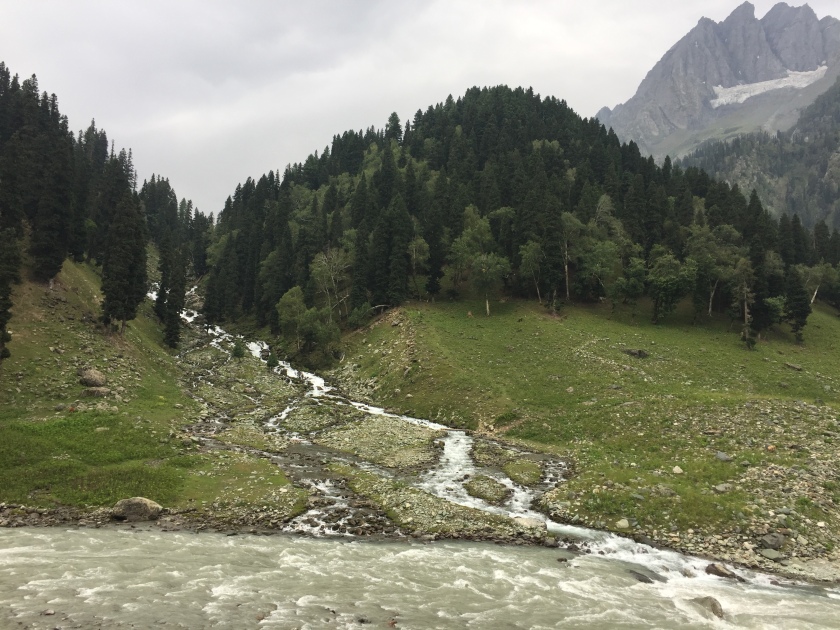
The Kashmir Great Lakes (KGL) trek happened to be one of those spontaneous and impulsive decisions that I sometimes undertake without much thought. This was nowhere in the radar, especially after having just done Rupin Pass in May. My rash and impulsive self, sprouting from acute impatience, sometimes turns out to be quite a boon. The thought of KGL occurred and in just five days, I found myself in an airplane towards Srinagar. The thought was, of course, fueled by certain other situations happening in my life.
These are things that make me believe that it’s the mountains who decide when, where, and how one sets foot on them.
To read about my experience of Rupin Pass, click here.

KGL, labelled as moderate to difficult, is said to be the prettiest trek in India. And, it indeed was! Words are not enough to describe the pristine beauty of this Himalayan fairyland with stretches of meadows dotted with colourful flowers, tall mountains of various shades, blue/green lakes nestled quietly here and there, wild horses lazing around, grazing sheep making the most of all the greens, twinkling streams that appear, disappear, and reappear, and so much more.
In this post, I will write about the lakes. The meadows and the rest will follow in another post.
[Note: I have shared pictures in another post, will share some more and this time with descriptions.]
Peace and Tranquillity at Vishansar Lake
It was Day-3 of the trek, when we encountered Vishansar Lake and it was the first lake of the trek. We had camped at the base of a hill, on the other side of which lay this lake. Vishansar, with its scintillating radiance glimmering in the soft afternoon sun stole my heart at the very first glance and remained my most favourite lake of the trek. It was late afternoon and at that hour the lake appeared a greenish blue with the Kishansar Peak standing tall across the quiet waters.
Situated at an elevation of 3710 m. Vishansar, also known as Vishusar, literally translates as the lake of Lord Vishnu. Fed by Kishansar Lake and many glaciers, it is the main source of Neelam River, which is a tributary of Jhelum River. The lake freezes during winter and is home to many fishes, including the Himalayan Brown Trout. At this time of the year, the month of September, it was surrounded by lush green meadows that provided the perfect pastures to flock of sheep and goat that pass by.


We spent the entire afternoon and evening walking by the side of the lake soaking in the stillness of the quiet valley. The only sound that pervaded this silence once in a while was the bleating of sheep and the whistling of shepherds. The tranquility and calmness appealed to my senses in a way that I can still feel the same when I imagine Vishansar.
As evening crawled in, it started drizzling forcing us to leave the lake side and walk back to our camp.
The Sweet Waters of Kishansar Lake
It was Day -4 and we woke up to a bright day. The sun shone softly, interrupted by occasional clouds and the gloom from the previous evening had disappeared. This was a day of steep ascents and descents. The first stretch of climb led us away from Vishansar, which was a deep blue at this time with the early morning sunshine. Viewing the clear reflections of the Kishansar Peak, from the mountain top made for the start of a very beautiful day.
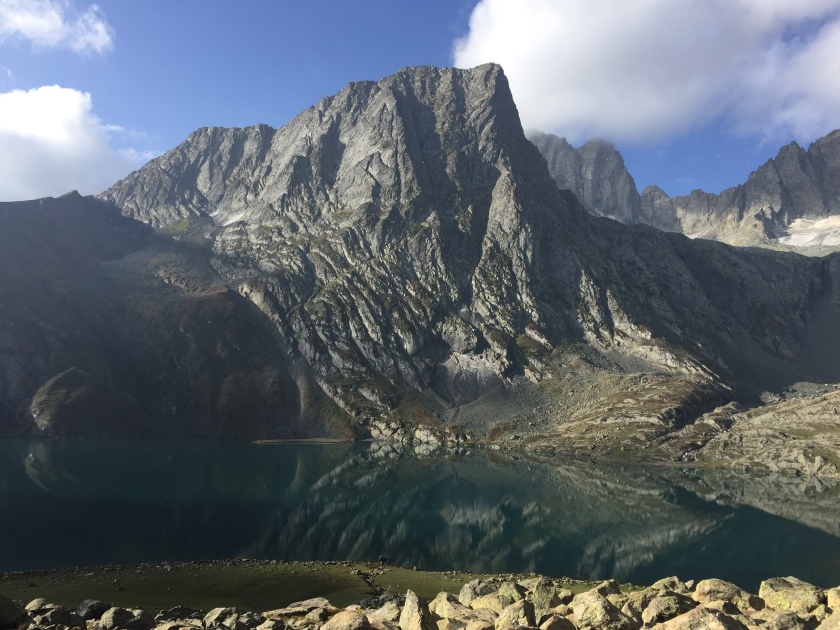
Soon, we came upon Kishansar which was smaller in size as compared to Vishansar. Most people in our group were satisfied with the far away view we had from the trail. Wanting a closer view, I walked off the trail towards the lake when I spotted a fellow trekmate headed in the same direction. Now there was no stopping and the two of us went up to the shore of the lake.

The sparkling clear waters shining in the morning sun was divine. We felt compelled to cup our hands and drink the water. It was the sweetest water I ever tasted and I couldn’t stop at one. Every sip seemed sweeter than the one before. This is attributed to the oligotrophic nature of these lakes.
[Oligotrophic lakes have low nutrient content resulting in low algal production, and consequently, have very clear waters with high oxygen content that is of high drinkable quality.]



Kishansar literally translates as the lake of Lord Krishna and its divinity is for one to feel. Situated at a height of 3710 m above sea level, Krishnasar is fed by melting glaciers. It outflows to Vishansar Lake and Neelum River. This lake also freezes during winter.
A very steep ascent followed Kishansar that took us up to Gadsar Pass. It was a tough climb but the fascinating view of the twin lakes from the top of the pass was more than worth the trouble. I will let the picture do all the talking here.

The Uneasy Quiet at Gadsar Lake
The wind was blowing hard at Gadsar Pass. After spending a couple of minutes soaking in the spectacular sight that seemed more like a dream than reality, we moved on. Passing through a steep and tricky descent through dry scree, we walked through endless meadows and reached Gadsar Lake.
At an elevation of 3810 m., the spectacular Gadsar looked like a huge bowl of moss green water that was perfectly still. Gadsar literally translates to lake of fishes and it is a natural habitat for trout and other types of fishes. There were tall mountains across the lake where we could clearly see the glaciers with a continuous flow of water towards the lake.
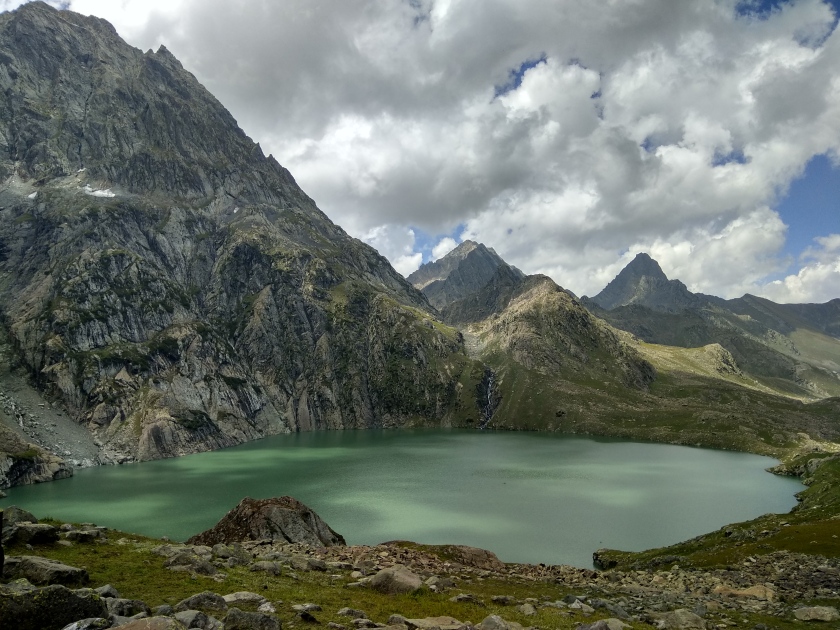
The scene in its entirety was glorious but somewhat intimidating. The lake seemed to be of indefinite depth and it made me feel a little uneasy. Possibly it was the story narrated by our guide warning me not to go down to the lake as I had done at Kishansar. Apparently, Gadsar lake is referred to as lake of death and it is also known as Yemsar, which translates into lake of demons. Locals believe that there lives a huge monster at the lake, which is something like an Octopus that drags creatures with its tentacles. Shepherds refrain from grazing their flocks at the shores of this lake.
Such little anecdotes don’t fail to fascinate me though! And I so love them.
Flocks of Sheep and Goat at Satsar
Crossing an army camp situated atop a hill, we noticed the sparkling colourless waters of a lake lying against the barren mountains. We briefly walked over boulders sharing space with shepherd families, who were migrating and moving out as winter was soon approaching. Just behind us was a flock of 200-300 goats, manned by shepherds and sheep dogs. An equally large flock of sheep was also walking on the flat land right beside the Lake.

This was one of the Satsar Lakes. Satsar literally translates as seven lakes. It is actually a collection of 7 water pools in the narrow alpine valley that are connected to one another through streams. However, we could see only three. Two had dried up as it was the fag end of monsoon. Two lie behind the mountains, not easily accessible though we did plan to attempt it after getting done with lunch at our campsite. However, the Rain Gods decided otherwise and poured their hearts out forcing us to remain in our tents.
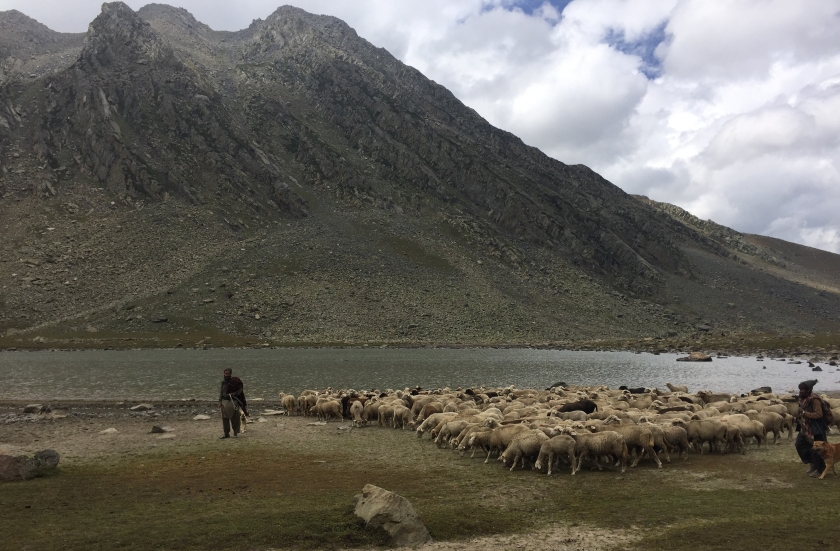


All Pervading Divinity at Gangabal Lake
We were in for a visual treat once again from the top of Zajibal Pass. The twin lakes of Gangabal and Nandkol were like two gems of shining sapphire embedded at the base of Harmukh Peak. The backdrop of Harmukh Peak, partially covered by clouds added to the surrealistic character of the moment. Harmukh glacier hung on the rocky edges of the mountain quietly and happily feeding the two lakes.

Each one of us enjoyed the splendour in our own way. Some of us sat quietly soaking in the spectacular sight, some others were capturing the moment in various ways with their cameras. It was a cloudy day and the Pass was really cold, we had to leave sooner than we would have wished to. Besides these two lakes, there were two others almost hidden in the mountain pockets. I noticed them only when they were pointed out to me. These two were greyish black in colour and known as Kalasars.
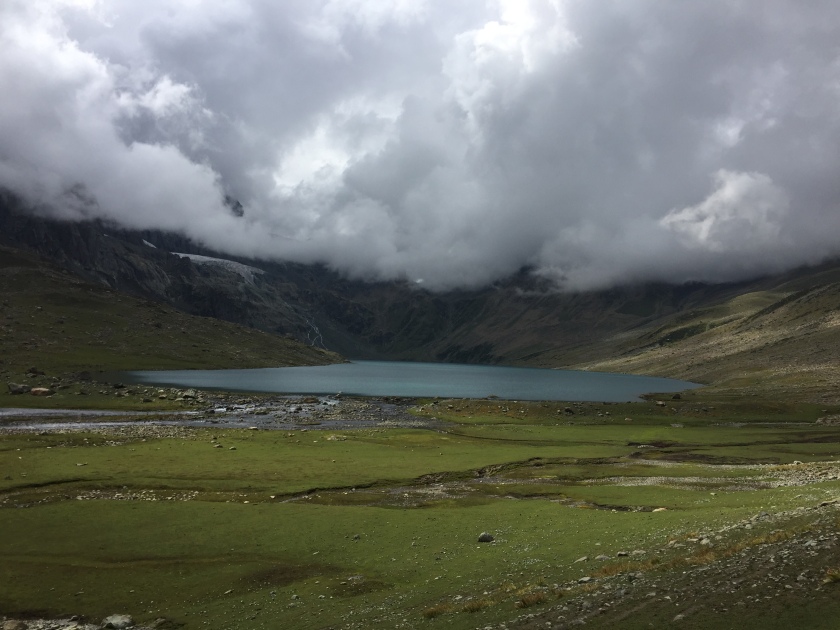
After a tricky descent through the steep mountain side, we walked beside a stream and came face to face with Gangabal. The shores of Gangabal, named after River Ganges, exuded divinity with the cloud-covered Harmukh Peak looking on. Feeling compelled to experience more of the quietude, I found myself a flat rock, opened my shoes, soaked my feet, and drifted to a different world. While some of my trek mates went on to take a dip in the lake, some others joined me in my reverie.


Gangabal is large at a length of 2.5 Km. and a width of 1.0Km and drains into Sindh River. Locals worship Gangabal and Nandkhol and indulging in a parikrama or a circumambulation seemed to be the most logical thing to do. However, that would easily take an hour and after the long walks that we already had, most of us preferred just sitting down.
Sheer Elegance of Nundkol Lake
A sizzling stream connects Gangabal to Nundkol. We walked from Gangabal, crossed the stream at several place and arrived at Nundkol. At Nundkol the dark clouds hovering around Harmukh Peak gave us a small window to catch a glimpse of the massive mountain.
Nundkol was as elegant as all the other lakes but there were tents dug up all along the shore, which was an eyesore to this scenic place. It was surprising that camping is allowed on the shores of this pristine lake.


Our tents were away from the lake and the following morning I accompanied a fellow trekmate to Nundkol again. Remnants of camping were strewn all around. There was plastic and various kinds of non-degradable items lying at the shore of the lake that really saddened us. We had walked on the other side of the lake the day before and that was cleaner. The sight was so disheartening.
I really wish I could do something, at least collect a few of the garbage but we had already packed and the team was ready to leave, I had no time to do anything. This still makes me feel terribly guilty. I can only hope that the authorities take note of this and camping in the periphery of the lake is completely prohibited.
To read my experience of Kashmir Great Lakes trek, click here.

Incredible landscape. But the walk sounds a bit more difficult than crossing a road in Mumbai 🙂 Not something I would decide to do quite suddenly.
LikeLiked by 2 people
Yes, the walk was very exhausting. Every day was very long, with steep ascents and descents. Hopping through boulders and walking through moraines in addition to stretches of beautiful meadows was common place. Will write the day-wise description later.
But it’s beautiful and I do wish you could go 😊
LikeLiked by 2 people
Lovely post, the pictures are glorious. Thank you for sharing this special journey!
LikeLiked by 2 people
Thank you, Jordan. So nice of you to read and leave behind a comment 😊
LikeLiked by 1 person
Some stunning landscape,Neel. The picture no 4 is so beautiful with sheeps grazing near the lake. Have you heard this saying – Himalaya ek keeda hai jo kaat le to aadmi ko baar baar vapas bulata hai”? This is what a guide once told me during a high altitude trek in the Himalayas.
LikeLiked by 3 people
Yes Arvind, I did hear this too and that keeda has bitten me for sure 😀
Which treks have you been to? Would love to know.
LikeLiked by 1 person
I have been to a very few of them 😦 VOF, Roopkund, HKD….now I trek mostly here in Aravalis on a regular basis which means I get to trek every week, a couple of hours!
LikeLiked by 1 person
Three treks in the Himalayas is quite a good number I feel as these treks require good amount of planning. And you’ve been to some of the best ones and even Roopkund, wow. I would love to trek in the Aravalis someday 🙂
LikeLiked by 1 person
All these were chosen for some reason because I like an element of each. I just wouldn’t do any trek for the sake of it. The appeal is quite important. Aravali differs in so many ways. The most important is that there are hardly any trails. In reality, the element of adventure is much higher than Himalayas (the organized trek part). I have been thinking of writing the difference between both terrains. Someday!
LikeLiked by 2 people
I see, quite interesting. Have you written about those and what attracted you there? Would love to read. Trekking without a trial is absolutely so much more adventurous. I had done that once in the outskirts of Bangalore. It was a different experience. Please do write as you are well aware of both. It will make for a great read.
LikeLiked by 1 person
Neel, I have never written a usual travelogue. I have written about VOF but it was an FAQ style guide. I don’t think I can write a guide for a multi-day trek. I have a post on HKD in my draft for over a year, and I’m yet to find “right” mood to finish it. The other one that I mentioned, I will write some time soon. haven’t even decided what I will write… LoL! The advantage with weekend treks is that they are ongoing so no travel and break. That’s another issue that you don’t get to unwind completely!
LikeLiked by 1 person
Oh yes, this reminds me I did read the VoF blog 🙂
Hoping you’ll complete HKD soon, would love to read.
Agree with your point on weekend treks totally.
LikeLiked by 1 person
Sure. Let me see when I get inspiration to do so! 🙂
LikeLiked by 1 person
Very well written, Neel! Relived the days as I read through the posts. Looking forward to the detailed day-by-day post of the trek.
LikeLiked by 2 people
Thanks so much, Agni. Tried to make the post smaller but it wasn’t happening. Most of us don’t have the patience, you did but 😀
LikeLike
This is so beautiful! You are blessed to have witnessed such sights. I wonder if I would be able to attempt such high altitude treks. But this surely makes me want to go to the Himalayas right away! (I feel like crying like a baby and screaming out loud so that God can hear me. Hehe!)
LikeLiked by 3 people
Hariom, I totally understand your emotions. The first time my sister saw the Himalayas up close she couldn’t stop the tears flowing out 😊
And what makes you think you can’t, you definitely can. Rather am sure you will, given the nature lover that you are. You are welcome to join me sometime 😊
LikeLiked by 3 people
Wonderful description, amazing beauty.
LikeLiked by 1 person
Thank you so much for visiting and reading.
LikeLike
A nice report! But you are really lucky because in Europe there will be always snow or ice on such an altitude oft 3,800 m. In August we even had a little bit oft snow coming down to 1,500 m one morning at Eastern-Tyrole what may happen seldomly sometimes. Only Mt. Teide (3,750 m) on Tenerife, Canary Islands, free of snow in Summer usually, but this is far away from the European main continent.
LikeLiked by 2 people
That’s true. Last time while on Rupin Pass Trek I had met a couple from Germany, they were talking about exactly the same thing 🙂
Thank you for reading, the post is rather long. I did attempt to make it shorter but the keyboard sometimes gets the better of me!
LikeLiked by 1 person
For me it is not too long, but I am aware that many people in the blogosphere only look for nice pictures without reading the background texts accompanying pictures or graphics. Some kind of Instagram-based ignorance ….
LikeLiked by 1 person
I am so glad to hear that, in this age of the fast-paced patience is almost lacking 😀
Usually people just skim through content and focus on pictures as you mention rightly.
I admit to doing that too sometimes, but if it is something of my interest I read however long it maybe.
LikeLiked by 1 person
Incredible Himalayas and beautiful written.
LikeLiked by 1 person
Thank you so much. Really appreciate your taking time to read this 🙂
LikeLiked by 1 person
I loved seeing your photos. I had long thought it improbable we would ever get to the Himalayas ourselves and our current trip proved it when Alie had altitude problems at 9,000 feet. But it is a pleasure to visit them through your eyes.
LikeLiked by 1 person
Thank you Roland. I feel honoured to receive this comment from an avid traveller like you 😊
LikeLike
When living in Finland, Your landscapes seem to be incredibly gorgeous. Thank You sharing them.
Have a good day!
LikeLiked by 1 person
Thank you so much for stopping by. I am so glad you liked it.
LikeLiked by 1 person
These are hidden gems for sure. 🙂
LikeLiked by 1 person
Thank you so much. They were stunning and divine 🙂
LikeLiked by 1 person
Pristine beauty
LikeLike
That’s an amazing post with breathtaking pictures.
LikeLiked by 1 person
Thank you, Raj. Glad you enjoyed it 🙂
LikeLike
wooooooooowwwwwwww!!!!!
I was here coz my friend wanted me to refer a travel blog. I am so busy these days, I dont check updates on wordpress, Im missing all of these. So Im glad I came here right now.
“Even a week before I didn’t know that I would be here.” How do you prepare yourself for such a big trip? Really amazing.
“prettiest trek in India” I can see why.
“We spent the entire afternoon and evening walking by the side of the lake soaking in the stillness of the quiet valley.” Im getting goosebumps, well, that would be the biggest understatement. Thank you for sharing your journey, the pictures are truly breathtaking. I feel refreshed. I’d love to go there someday.
LikeLiked by 1 person
No wonder I don’t see you a lot these days. I was thinking in fact that probably you are very busy with your work. The KGL trek was indeed one of a kind. I am yet to write the detailed day-to-day post for this trek. As for planning in a week, that doesn’t happen always. This one was related to several situations playing together in my life at that point of time. And, all of that converged into this beautiful journey. I do hope you do get to go here some time. 🙂
And, a very big thank you for visiting and reading and writing this lovely note 🙂
LikeLiked by 1 person
It was my absolute pleasure going through this wonderful post. My new job requires me to do a lot of research and thats what i’ve been doing. And when Im free I either take guitar lessons or just play video games. Today I took an online trek thanks to you, it was truly refreshing.,
LikeLiked by 1 person
Makes me happy that you took a virtual trek with me 🙂
I am assuming this job also lets you do work from home. Those guitar lessons must be the best breaks for you 🙂
LikeLike
What a stunning place and love your photos! Hopefully I will see Kashmir one day. 🙂
Many thanks for stopping by my Travel and Photography blog.
LikeLiked by 1 person
Thank you so much for reading my post. I do hope you come to India and trek here sometime 🙂
LikeLiked by 1 person
I’ve only visited India once and that was back in 1985 when I solo-backpacked around the world for 12 months. Some photos: https://www.nillasphotography.com/galleries/india-1985
I only have hard copy travel journals in storage back in Australia…one day I’ll publish them on my blog site. 🙂
I spent almost one month in India but mostly in Rajasthan, but nowhere near enough time.
LikeLiked by 1 person
Rajasthan has its own unique charm. Would love to read those posts! Thank you for sharing the photos, I will go and look up. I do hope you get to trek in India sometime, especially the Himalayas.
LikeLiked by 1 person
If I ever return to Australia, I’ll dig out those journals – I have around 20 for 20+ years of travel.
So do I, it’s a dream of mine… 🙂
LikeLiked by 1 person
Good to read about your environmentally-tuned mind, the way you felt sad on seeing garbage strewn beside the lake. Not all trekkers have such.
The pictures of the lakes are so beautiful. Just thinking, then how beautiful the real sights must have been. Hope to be there some day.
One thing, so does ‘sar’ mean ‘lake’, and if so, in which language? Another thing I should say here as well, reading these descriptions in your blogs increase one’s knowledge of geography too. I like the fact that ‘Neelam’ is a tributary of the rhymingly-named ‘Jhelum’! 😊😀
LikeLike
This is surreal! The pictures are astonishing and the accompanying write-up brings out the serenity OF the experience even more 🙂
I remember reading Arvind’s post about the increasing waste problem in the Himalayas long back but I had hoped that at least the Paradise on Earth would have been spared of this menace. Disheartening to know that is not so. I wonder how can people come all the way to witness these exotic locales and then not feel even a tinge of guilt leaving them in a mess of waste? I really hope that the authorities do the needful.
Coming back to the post! The local tales associated with places are indeed, fascinating to say the least 🙂
I had bookmarked this post back when you had posted it but wanted to read them at leisure. I would now go on to the other posts in this series!
Cheers & keep Trekking 🙂
LikeLiked by 1 person
I am really delighted to see your thoughts and so glad that you read this post. So a very big thank you.
About the littering I have no words to express how anguished I feel. To tell you the truth I feel guilty of being part of this as I am also adding to it indirectly even if not directly. Plus, if I am not able to do anything about it what good am I just talking about it. I think limiting footfalls would be a good thing to do like it has been done in certain parts of the world, even if that means some of us may never get to witness this. Not sure if the authorities care enough. I was surprised to see that camping was even allowed right beside the Nundkol lake. I can tell you, at least 80% of the people I met during treks only talk but don’t care, which you can tell by their action. In Chandrataal (in Spiti) for example, no vehicles or camps are allowed within 1Km radius of the lake. Something like this should be done.
And, even as I say all these I know I will go there again. 😦
LikeLike
It’s a always a pleasure to read such well written posts 🙂
And you aren’t alone. Even though my friends and I make sure that we don’t add to the litter on the trails, we haven’t done anything to solve the problem either. It breaks my heart when my friends deduce the correct trail based on the number of plastic wrappers dotting it. Although there a few commercial groups who organise outings to clear trails and forts, they are few and infrequent and I have never been able to make it to one as yet. Limiting the number of people allowed to visit the place is a good idea but in places where the locals aren’t very well off, this can create a host of other problems as well. Disallowing camps though, can be a great way to solve this menace! And even if they do, certainly not close to water bodies.
LikeLiked by 1 person
Yes, you’re right about the effects of limiting people on local people. A double edged sword this is. I have been in the same situation about joining the cleaning campaigns. I have been trekking with Indiahikes. They do have a well defined green trail concept, which they implement with sincerity but they cannot monitor each and every trekker. Many people are conscious themselves but not all. In fact I have come across one or two exceptional individuals who are exemplary in how they conduct themselves. There’s a lot to learn from such people but sadly they are only just a few.
LikeLiked by 2 people
I agree. Organisations can only do so much and real change can only happen when the buck stops with each person. I hope people heading to these exotic locations do their best to make sure they leave the place just as pristine as they found it and hopefully, we do our best too 🙂
LikeLiked by 1 person